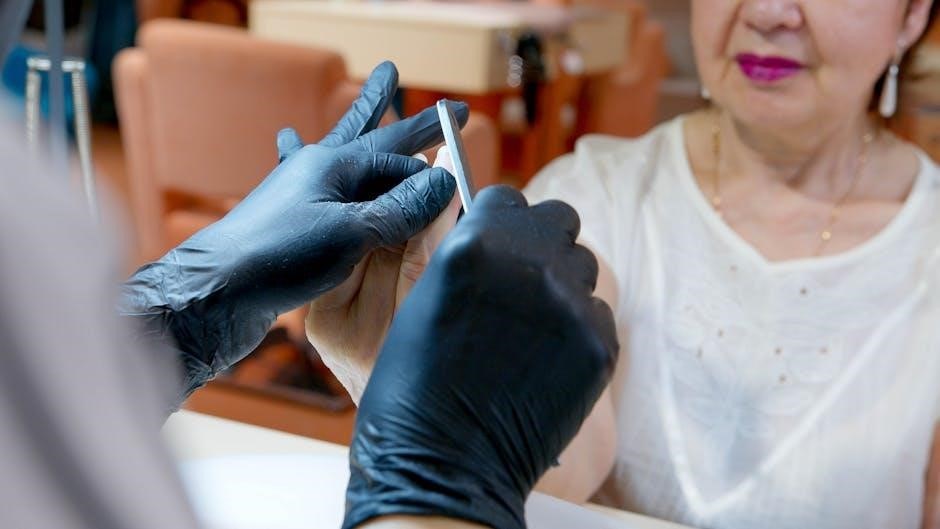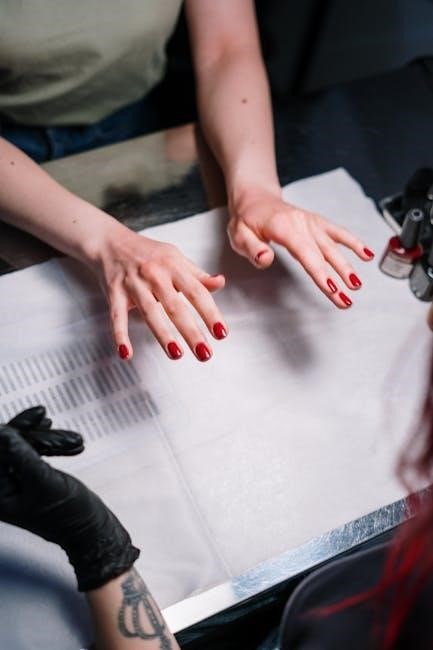nail salon business plan sample pdf
Executive Summary
The executive summary outlines the vision, mission, and objectives of a nail salon business, highlighting key services, target demographics, and a unique, responsible approach to beauty.
1.1. Overview of the Nail Salon Business
The proposed nail salon aims to offer high-quality beauty services, including manicures, pedicures, nail art, and additional spa treatments. Designed to cater to diverse clientele, the salon will feature a modern, inviting atmosphere, reflecting current design trends such as Scandinavian or classic styles. Emphasizing a responsible business approach, the salon will prioritize sustainability and customer satisfaction. Targeting professionals, individuals, and groups seeking relaxation and beauty enhancements, the salon will provide a welcoming space for all. With experienced staff and a commitment to excellence, the business strives to become a trusted destination for beauty care, ensuring superior service and personalized experiences.
1.2. Vision and Mission Statement
The vision of the nail salon is to become a leading destination for beauty and wellness, offering exceptional services that exceed client expectations. Our mission is to provide high-quality nail care, hair, skin, and spa services in a clean, safe, and inviting environment. We are committed to using sustainable practices and promoting a responsible business approach. By understanding diverse client needs, we aim to deliver personalized experiences that foster long-term relationships. Our goal is to enhance beauty, well-being, and confidence through innovative techniques and a passionate team. Sustainability, excellence, and customer satisfaction are at the heart of everything we do, ensuring a welcoming space for all.
1.3. Objectives and Goals
The primary objectives of the nail salon include delivering exceptional beauty services, ensuring customer satisfaction, and building a loyal client base. Goals encompass achieving a 90% customer satisfaction rate within the first year, attracting 200 new clients monthly, and maintaining a 75% client retention rate. The salon aims to offer high-quality products, expand its service menu annually, and adopt sustainable practices to reduce its environmental footprint. Additionally, the salon strives to establish partnerships with local businesses and participate in community events to enhance its visibility. These objectives are designed to drive business growth, foster a positive reputation, and position the salon as a trusted beauty destination in the market. Achieving these goals will ensure long-term success and profitability.
1.4. Unique Selling Proposition (USP)
The salon’s Unique Selling Proposition (USP) lies in its commitment to delivering exceptional, personalized beauty experiences while promoting sustainability. By offering a wide range of high-quality nail and beauty services, the salon caters to diverse client preferences, ensuring a memorable experience. The use of eco-friendly products, a clean and modern interior design, and a team of skilled professionals set the salon apart from competitors. Additionally, the salon focuses on building strong client relationships through tailored services and a customer-centric approach. This combination of quality, sustainability, and personalized care positions the salon as a trusted and innovative destination for beauty enthusiasts, fostering loyalty and satisfaction. The salon’s USP emphasizes excellence, creativity, and a responsible business ethos.

Market Analysis
The nail salon industry is growing rapidly, driven by increasing demand for grooming and beauty services. The target market includes young professionals and beauty-conscious individuals seeking premium services.
2.1. Industry Overview
The nail salon industry is experiencing steady growth, driven by increasing demand for personal grooming and beauty services. Key services include manicures, pedicures, and nail art, catering to diverse client preferences. The market attracts a broad demographic, from young professionals to beauty-conscious individuals seeking premium services. With rising competition, salons are distinguishing themselves through quality, hygiene, and innovative offerings. The industry’s growth is further supported by evolving beauty trends and a growing awareness of self-care. To remain competitive, salons must adapt to changing consumer preferences and invest in effective marketing strategies, ensuring a strong presence in both local and digital markets.
2.2. Target Market and Customer Demographics
The target market for a nail salon includes a wide range of demographics, with a primary focus on females aged 18-45, who are the most frequent consumers of nail care services. This group includes working professionals, students, and individuals seeking pampering or preparing for special events. Additionally, the salon may attract males and non-binary individuals interested in grooming services. Income levels vary, but the core clientele typically includes middle- to high-income individuals who value beauty and personal care. Geographically, the salon will cater to local residents, office workers, and tourists in urban or suburban areas with high foot traffic. The target market also includes individuals seeking convenience, quality, and personalized experiences, making them willing to pay a premium for exceptional service and ambiance.
2.3. Competitive Analysis
The nail salon industry is highly competitive, with numerous establishments offering similar services. Key competitors include local salons, chain stores, and spas providing nail care. These competitors often focus on affordability, convenience, and a wide range of services. To stand out, the salon will emphasize superior quality, personalized experiences, and a welcoming atmosphere. By offering specialized nail art, premium products, and skilled technicians, the salon aims to attract discerning clients willing to pay for excellence. Additionally, a strong focus on hygiene, sustainability, and customer satisfaction will differentiate the business from competitors. Understanding the strengths and weaknesses of competitors is crucial for positioning the salon as a top choice in the market;
2.4. Market Trends and Growth Opportunities
The nail salon industry is experiencing steady growth, driven by increasing demand for personalized beauty services and self-care routines. Current trends include a rise in popularity of nail art, gel extensions, and eco-friendly products. Consumers are seeking premium services and unique experiences, creating opportunities for salons to offer specialized treatments. Additionally, the integration of technology, such as online booking systems and digital consultations, is enhancing customer convenience. Expansion into complementary services like hair and skin care can further attract a broader clientele. By leveraging these trends, the salon can capitalize on growth opportunities, ensuring long-term success and a strong market presence.

Services Offered
The salon provides a variety of nail services, including manicures, pedicures, and nail art, along with additional beauty options like hair, skin, and spa treatments.
3.1. Nail Services (Manicure, Pedicure, Nail Art)
The salon offers a range of nail services, including classic and deluxe manicures, pedicures, and intricate nail art designs. Manicures include options like gel, acrylic, and dipping powder applications, ensuring long-lasting results. Pedicures feature relaxing foot massages, exfoliation, and moisturizing treatments for ultimate pampering. Nail art services cater to individual preferences, from subtle designs to bold, creative patterns. Additionally, the salon provides express services for clients with limited time. All services use high-quality, non-toxic products to ensure safety and durability. The skilled team of nail technicians is dedicated to delivering precise, personalized care, making every client feel confident and satisfied with their final look.
3.2. Additional Beauty Services (Hair, Skin, Spa)
Beyond nail care, the salon offers a variety of additional beauty services to cater to a holistic beauty experience. Hair services include professional haircuts, coloring, and styling options tailored to individual preferences. Skin treatments feature facials, deep cleanses, and rejuvenating therapies to enhance natural glow. Spa services such as massages, body wraps, and hydrotherapy provide relaxation and rejuvenation. The salon also offers specialized treatments like hair reconstruction and advanced cosmetology procedures using cutting-edge techniques. All services are performed by trained professionals using premium, non-toxic products to ensure safety and effectiveness. The goal is to create a serene, one-stop destination for beauty and wellness, catering to diverse client needs and preferences while maintaining high standards of quality and care.
3.3. Special Packages and Discounts
To enhance client satisfaction and drive repeat business, the salon offers special packages and discounts tailored to diverse needs. These include bundled services like “Full Beauty Day” packages combining hair, nail, and spa treatments. Loyalty programs reward frequent clients with points redeemable for discounts or free services. Referral incentives encourage clients to bring friends, offering both parties a discount on their next visit. Seasonal promotions and limited-time offers create urgency and attract new customers. Additionally, discounts for students, seniors, and off-peak hours make services more accessible. These strategies aim to increase customer loyalty, boost foot traffic, and maximize revenue while maintaining a competitive edge in the market.
3.4. Customization Options for Clients
The salon empowers clients to personalize their beauty experience through tailored services. From choosing nail art designs to selecting preferred colors and finishes, clients can customize their look to suit their style. Additionally, personalized beauty treatments, such as specialized skincare and hair care, are offered based on individual needs. Clients can also opt for themed packages, such as bridal or festive designs, to match specific occasions. A pre-service consultation ensures every detail aligns with the client’s vision. This focus on customization enhances client satisfaction, fostering loyalty and encouraging repeat visits. By offering bespoke options, the salon stands out as a go-to destination for unique and personalized beauty solutions.

Marketing and Sales Strategy
Branding, promotional activities, and digital marketing are key to attracting clients. Social media platforms enhance visibility, while customer retention programs, like loyalty schemes, ensure long-term engagement and repeat business.
4.1. Branding and Logo Design
A strong brand identity is essential for attracting and retaining clients. The salon’s branding will reflect a modern, elegant aesthetic, with a logo featuring clean lines and vibrant colors to evoke freshness and style. The logo will incorporate elements that symbolize beauty, relaxation, and creativity, ensuring it stands out in the competitive market. A consistent brand image will be maintained across all platforms, from the salon’s interior design to digital marketing materials. The branding strategy will emphasize professionalism, quality, and a customer-centric approach, aligning with the target market’s preferences for a sophisticated yet welcoming beauty experience. This cohesive branding will help build trust and loyalty among clients.
4.2. Promotional Activities and Advertising
The salon will implement a multi-channel promotional strategy to attract and retain clients. This includes offering discounts for first-time customers, referral incentives, and loyalty rewards. Partnerships with local businesses and influencers will be established to cross-promote services. Seasonal campaigns and limited-time offers will be launched to create urgency and drive sales. Online advertising will target specific demographics through social media platforms, while offline efforts will focus on flyers, local newspapers, and community events. The salon will also host themed events, such as “Nail Art Nights,” to engage customers and build a loyal client base. These activities will ensure consistent visibility and attract diverse customer segments.
4.3. Digital Marketing and Social Media Presence
The salon will leverage digital marketing to enhance its online presence and attract clients. A strong focus will be placed on social media platforms like Instagram and Facebook to showcase nail art, customer testimonials, and special offers. High-quality images and videos will be regularly posted to engage the audience. The salon will also utilize Instagram Stories and Facebook Live for real-time interaction, such as live nail demonstrations or Q&A sessions. Additionally, targeted ads will be run to reach local demographics. An online booking system will be integrated with the website for convenience. Email newsletters will keep clients informed about new services, promotions, and events, fostering loyalty and repeat business.
4.4. Customer Retention Programs
To ensure long-term success, the salon will implement robust customer retention programs. A loyalty rewards system will be introduced, offering points for every service or product purchase, redeemable for discounts or free treatments. Referral incentives will encourage clients to bring friends, with discounts for both parties. Exclusive discounts for frequent visitors and special offers on birthdays or anniversaries of their first visit will foster loyalty. Regular communication through email newsletters will keep clients informed about new services, promotions, and events. Excellent customer service, personalized experiences, and consistent quality will also play a key role in retaining clients and building a loyal customer base for sustained growth.

Operations Plan
Operations Plan outlines salon location, design, equipment, and staffing. Includes a welcoming interior with modern amenities, skilled professionals, and efficient appointment management systems for optimal client experience.
5.1. Salon Location and Design
The salon will be strategically located in a high-traffic area, ensuring visibility and accessibility. The interior design will feature a modern, welcoming atmosphere, with elements such as stylish seating, ambient lighting, and aesthetic decor. The layout will include private areas for nail services, a self-service coffee station, and a comfortable waiting area equipped with TV screens. The design will emphasize cleanliness and hygiene, with state-of-the-art equipment and ergonomic furniture to ensure client comfort. The salon will also incorporate eco-friendly practices, reflecting a responsible business approach. The overall design will align with the brand’s vision, creating a relaxing and professional environment that enhances the client experience.
The location will be easily accessible by public transport, with ample parking options nearby. The salon’s design will cater to diverse client preferences, offering a blend of modern and classic styles to appeal to a broad demographic.
5.2. Equipment and Supplies Needed

To operate efficiently, the nail salon will require high-quality equipment and supplies. Essential tools include nail drills, UV lamps, and sterilization units for hygiene. Pedicure chairs, manicure stations, and comfortable seating are necessary for client comfort. The salon will also need disposable items like nail tips, buffers, and sanitizing solutions. Additional supplies such as nail polish, removers, and art tools will be sourced from reputable brands. Salon furniture, including styling chairs and storage units, will be selected for durability and aesthetics. A point-of-sale system and appointment scheduling software will streamline operations. All equipment will be regularly maintained to ensure safety and functionality, aligning with the salon’s commitment to professionalism and client satisfaction.
Sanitation equipment, such as autoclaves and disposable liners, will be prioritized to maintain a clean environment.
5.3. Staffing and Training
The salon will employ licensed and experienced nail technicians, stylists, and support staff to ensure high-quality services. Hiring will focus on professionalism, creativity, and customer service skills. Comprehensive training programs will be implemented to maintain consistency and excellence in services. Staff will receive initial training on salon procedures, safety protocols, and product usage, with ongoing education to stay updated on trends and techniques. Continuous feedback and performance reviews will help improve service quality. The salon will also ensure all staff meet local licensing requirements and adhere to health and safety standards. By investing in employee development, the salon aims to build a skilled and motivated team dedicated to exceptional client experiences.
Regular workshops and refresher courses will be conducted to keep the team up-to-date with industry advancements.
5.4. Appointment Scheduling and Management
An efficient appointment scheduling system is crucial for smooth salon operations. Clients will be able to book appointments online through the salon’s website or via phone. The salon will utilize digital calendar software to manage bookings, reducing wait times and ensuring optimal staff utilization. Automated reminders will be sent to clients to minimize no-shows. The system will also track appointment history and preferences to personalize services. This streamlined process will enhance client satisfaction and improve operational efficiency. By integrating appointment management with marketing efforts, the salon can offer tailored promotions and maintain strong customer relationships.
This approach ensures a seamless experience for both clients and staff, fostering loyalty and repeat business.

Financial Plan
The financial plan outlines revenue projections, startup costs, funding requirements, and pricing strategies to ensure profitability and sustainability for the nail salon business.
6.1. Revenue Projections
The nail salon projects steady revenue growth, with an estimated 50 clients per day at an average service price of $40. This translates to $2,000 daily revenue and $60,000 monthly. Annual revenue is expected to reach $720,000, with a 10% increase in the second year due to customer retention and expanded services. Key revenue streams include manicures, pedicures, nail art, and additional beauty services. The salon aims to achieve profitability within the first year, with net margins projected at 20%. These projections are based on market demand, competitive pricing, and effective marketing strategies to attract a loyal customer base.
6.2. Startup Costs and Funding Requirements
Starting a nail salon requires an initial investment of $150,000 to $200,000, covering location setup, equipment, and initial operational costs. Key expenses include salon design and interior ($50,000), high-quality equipment ($30,000), and essential supplies ($15,000). Additional costs include licensing, insurance, and staff training. Funding will be sourced through a combination of personal savings, bank loans, and potential investor contributions. A detailed breakdown of expenses ensures transparency and accountability. Securing sufficient funding is critical to launching a professional, attractive salon that meets customer expectations and stands out in a competitive market.
6.3. Pricing Strategy
The salon will adopt a competitive pricing strategy, ensuring affordability while maintaining high service quality. Basic manicures and pedicures will be priced at $15-$25, with premium options like gel and acrylics at $30-$45. Nail art and advanced designs will range from $10 to $30 extra, depending on complexity. Additional services, such as haircuts and facials, will be priced competitively based on local market rates. Discounts will be offered for first-time clients, student specials, and bundle packages to encourage repeat business. Loyalty programs will provide further incentives, ensuring long-term customer retention. Transparent pricing will be communicated clearly to build trust and attract a diverse clientele.

6.4. Profit and Loss Statement
The profit and loss statement will outline projected revenue and expenses over a three-year period. Revenue is expected to grow steadily, driven by core nail services, additional beauty offerings, and special packages. Fixed costs include salon rental, equipment, and staff salaries, while variable costs cover supplies and marketing. Projected net profit margins are estimated at 15-20% in the first year, increasing to 25-30% by year three as client base and efficiency grow. Detailed financial projections will be supported by monthly sales forecasts, ensuring a clear roadmap for achieving profitability and sustainability in the competitive beauty industry.

Management and Organization
The salon will be managed by an experienced team, including a salon manager and skilled professionals, ensuring efficient operations and high-quality service delivery.
7.1. Ownership Structure
The nail salon will operate as a sole proprietorship, with the owner holding full decision-making authority. Legal ownership is vested in the proprietor, ensuring streamlined management and direct accountability. This structure simplifies tax filings, as business income is reported on the owner’s personal tax return; The proprietor will oversee daily operations, financial management, and strategic planning. In the event of expansion, the ownership structure may evolve to a partnership or LLC to accommodate additional investors or partners, ensuring shared responsibility and diversified expertise. For now, the sole proprietorship model aligns with the initial startup phase, offering flexibility and control essential for establishing a strong market presence.
7.2. Key Roles and Responsibilities
The salon will have a clear hierarchy to ensure smooth operations. The Salon Manager will oversee daily activities, staff supervision, and customer service. Nail Technicians will specialize in manicures, pedicures, and nail art, maintaining high-quality standards; Hair Stylists will provide cutting, coloring, and styling services, while Spa Therapists will handle skin treatments and massages. A Receptionist will manage appointments, client records, and payments. A Marketing Specialist will develop promotional strategies to attract and retain clients. Each role is essential for delivering exceptional client experiences and driving business growth. Clear responsibilities ensure accountability and efficiency, fostering a cohesive team environment focused on achieving business objectives.
7.3. Human Resources Policies
The salon will implement clear human resources policies to ensure a professional and supportive work environment. These policies will include recruitment processes, employee contracts, and training programs. Staff will undergo regular training to maintain high service standards and industry knowledge. Health and safety protocols will be prioritized, with proper sanitation and hygiene practices enforced. Employees will be expected to adhere to a professional code of conduct, ensuring respectful interactions with clients and colleagues. The salon will also promote diversity, equity, and inclusion in hiring practices. Performance evaluations will be conducted regularly to provide feedback and opportunities for growth. These policies aim to foster a positive workplace culture, ensuring employee satisfaction and retention while delivering exceptional client experiences.
7.4. Legal and Licensing Requirements
The nail salon must comply with all local, state, and federal regulations, including business licensing, health and safety standards, and employment laws. A valid business license and nail technician certifications are essential. The salon will adhere to sanitation and hygiene regulations to ensure client safety. Zoning permits and fire safety inspections must be obtained prior to opening. Liability insurance will be secured to protect against potential risks. All employees will be trained on legal requirements and industry standards. Regular inspections will be conducted to maintain compliance with health regulations. The salon will also ensure proper documentation of employee qualifications and client records. Compliance with these legal requirements is critical to operating a trusted and safe business environment.
The nail salon business plan outlines a clear vision, strategic approach, and actionable steps to achieve success, ensuring high-quality services and customer satisfaction in a competitive market.
8.1. Summary of the Business Plan
The business plan for the nail salon outlines a comprehensive strategy to establish a successful beauty service provider. It covers key aspects such as market analysis, services offered, marketing strategies, operational setup, and financial projections. The plan emphasizes a vision to provide high-quality nail and beauty services, ensuring customer satisfaction and loyalty; By targeting a diverse demographic and leveraging competitive pricing, the salon aims to stand out in the market; The document also highlights the importance of a well-trained staff, modern facilities, and a strong online presence to drive growth. With a clear implementation timeline and actionable steps, the plan sets a solid foundation for long-term success.
8.2. Vision for the Future
The vision for the nail salon is to expand into a multi-service beauty hub, offering hair, skin, and spa services while maintaining its core nail care expertise. The salon aims to become a leader in the beauty industry by introducing advanced nail art techniques and sustainable practices. Future plans include opening additional locations and launching a line of eco-friendly beauty products. By integrating technology, such as online booking systems and virtual consultations, the salon will enhance customer convenience. The goal is to create a loyal client base by consistently delivering exceptional service and staying ahead of market trends. This vision underscores a commitment to innovation, quality, and customer satisfaction.
8.3. Risks and Contingency Plans
The nail salon faces risks such as intense competition, economic downturns, and changing consumer preferences. To mitigate these, the business will diversify services, ensuring adaptability to market shifts. Contingency plans include maintaining a financial reserve for unexpected expenses and implementing cost-effective marketing strategies to attract new clients. Staff training will focus on versatility, enabling employees to handle multiple roles during slow periods. Additionally, the salon will prioritize building strong customer relationships to foster loyalty. By monitoring industry trends and staying agile, the salon can address potential challenges effectively while maintaining its competitive edge in the beauty industry.
8.4. Next Steps and Implementation Timeline
The next steps involve finalizing the salon location, securing necessary licenses, and hiring trained staff. The design and equipment setup will follow, ensuring a welcoming environment. Marketing efforts will begin, focusing on local outreach and online presence to attract initial clients.

The implementation timeline includes location scouting within the first month, with renovations and equipment installation completed by month three. Staff hiring and training will occur in month two, with a soft launch planned for month four. A grand opening event will follow in month five to officially introduce the salon to the community. Regular reviews will ensure progress aligns with business goals, ensuring a smooth transition from planning to operational success.
